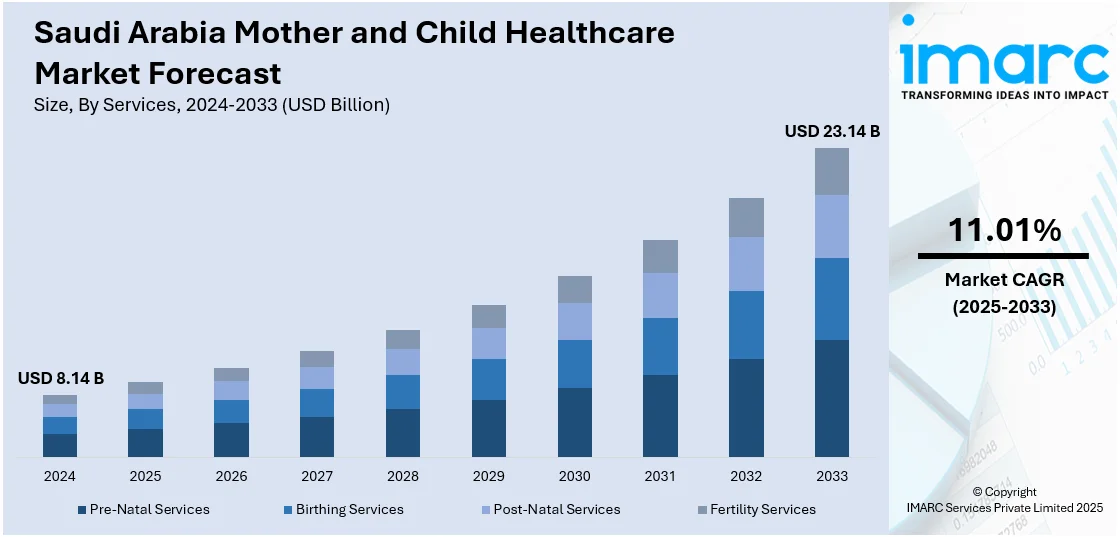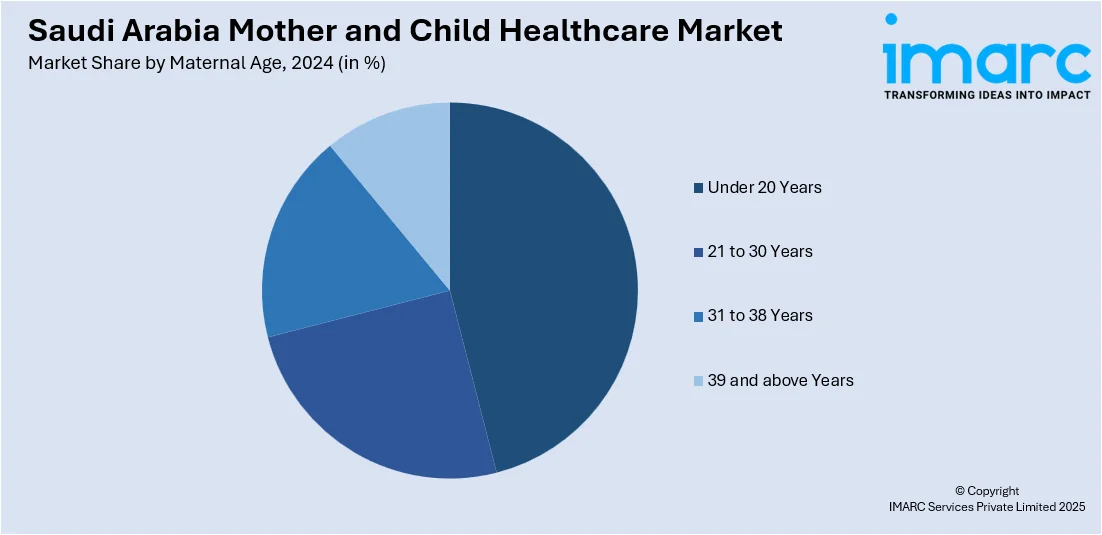
Saudi Arabia Mother and Child Healthcare Market Size, Share, Trends and Forecast by Services, Maternal Age, Location, and Region, 2025-2033
Saudi Arabia Mother and Child Healthcare Market Overview:
The Saudi Arabia mother and child healthcare market size reached USD 8.14 Billion in 2024. Looking forward, IMARC Group expects the market to reach USD 23.14 Billion by 2033, exhibiting a growth rate (CAGR) of 11.01% during 2025-2033. The market is being driven by government-led healthcare reforms under Vision 2030, substantial investments in maternity infrastructure, growing awareness among women about the importance of prenatal and neonatal care, rising birth rates, advancements in telemedicine, and the expanding presence of private healthcare providers offering specialized maternal and pediatric services.
|
Report Attribute
|
Key Statistics
|
|---|---|
|
Base Year
|
2024
|
|
Forecast Years
|
2025-2033
|
|
Historical Years
|
2019-2024
|
| Market Size in 2024 | USD 8.14 Billion |
| Market Forecast in 2033 | USD 23.14 Billion |
| Market Growth Rate 2025-2033 | 11.01% |
Saudi Arabia Mother and Child Healthcare Market Trends:
Government Policy Reforms and Vision 2030 Initiatives
Among the key drivers of Saudi Arabia's mother and child healthcare market is the country's comprehensive policy reforms under the Vision 2030 program. This long-term strategic framework seeks to diversify the economy and enhance the quality of life for the citizens of Saudi Arabia, including access to improved healthcare services for mothers and children. Much of the health transformation under Vision 2030 is focused on improving maternal and neonatal health outcomes, decreasing infant and maternal mortality, and increasing universal health coverage. Under this program, the Ministry of Health has introduced various programs in terms of prenatal care, safe childbirth protocols, postnatal services, and pediatric health. Public-private partnerships have also been promoted to bring in investment in specialized mother and child clinics. The government is spending considerable financial budgets in establishing sophisticated maternity hospitals, imparting training to healthcare professionals in the fields of gynecology and pediatrics and embracing digital health technologies to enhance patient monitoring and follow-ups.

Rising Awareness and Changing Cultural Norms
Another factor driving the mother and child healthcare market in Saudi Arabia is the increasing awareness among women due to elevating levels of education, social media trends, and changing cultural attitudes. Historically, the Kingdom tended to restrict women's access to healthcare or delegated vital reproductive choices to male guardians. Nonetheless, the past years have seen a cultural shift towards women’s autonomy, with women gaining information and independence in terms of how they approach their healthcare. Education reforms have led to an increase in women seeking higher education, particularly in health science and early childhood care. The education improvement has led to an upsurge in the health-literate population, especially among expectant and new mothers. Women are now seeking evidence-based prenatal and postnatal services, vaccinations for children, and mental health counseling for postpartum complications. Moreover, the extensive use of digital media and social media has eased access to information regarding maternal and child health. Social media influencers, health bloggers, and awareness campaigns have helped in shattering long-standing taboos regarding issues such as breastfeeding, family planning, and childbirth choices.
Saudi Arabia Mother and Child Healthcare Market Segmentation:
IMARC Group provides an analysis of the key trends in each segment of the market, along with forecasts at the region/country level for 2025-2033. Our report has categorized the market based on services, maternal age, and location.
Services Insights:
- Pre-Natal Services
- Birthing Services
- Post-Natal Services
- Fertility Services
The report has provided a detailed breakup and analysis of the market based on the services. This includes pre-natal services, birthing services, post-natal services, and fertility services.
Maternal Age Insights:

- Under 20 Years
- 21 to 30 Years
- 31 to 38 Years
- 39 and above Years
A detailed breakup and analysis of the market based on the maternal age have also been provided in the report. This includes under 20 years, 21 to 30 years, 31 to 38 years, and 39 and above years.
Location Insights:
- Hospitals
- Nursing Homes and Clinics
- In-Home Services
- Others
The report has provided a detailed breakup and analysis of the market based on the location. This includes hospitals, nursing homes and clinics, in-home services, and others.
Regional Insights:
- Northern and Central Region
- Western Region
- Eastern Region
- Southern Region
The report has also provided a comprehensive analysis of all the major regional markets, which include Northern and Central Region, Western Region, Eastern Region, and Southern Region.
Competitive Landscape:
The market research report has also provided a comprehensive analysis of the competitive landscape. Competitive analysis such as market structure, key player positioning, top winning strategies, competitive dashboard, and company evaluation quadrant has been covered in the report. Also, detailed profiles of all major companies have been provided.
Saudi Arabia Mother and Child Healthcare Market News:
- April 2025: Saudi Arabia launched 28 healthcare projects worth USD 1.86 billion across Riyadh's health clusters, significantly expanding the nation's medical infrastructure. A key component is the new 500-bed Women’s, Maternity, and Children’s Hospital at King Saud Medical City, which enhances maternal and pediatric care.
- November 2024: Johns Hopkins Aramco Healthcare (JHAH) in Dhahran became the first private hospital in Saudi Arabia's Eastern Province to receive Baby-Friendly Hospital accreditation, recognizing its commitment to high-quality maternal care. Such advancements in maternity care are driving the Saudi mother and child healthcare market by setting new standards and bolstering the demand for quality maternal services.
Saudi Arabia Mother and Child Healthcare Market Report Coverage:
| Report Features | Details |
|---|---|
| Base Year of the Analysis | 2024 |
| Historical Period | 2019-2024 |
| Forecast Period | 2025-2033 |
| Units | Billion USD |
| Scope of the Report |
Exploration of Historical Trends and Market Outlook, Industry Catalysts and Challenges, Segment-Wise Historical and Future Market Assessment:
|
| Services Covered | Pre-Natal Services, Birthing Services, Post-Natal Services, Fertility Services |
| Maternal Ages Covered | Under 20 Years, 21 to 30 Years, 31 to 38 Years, 39 and above Years |
| Locations Covered | Hospitals, Nursing Homes and Clinics, In-Home Services, Others |
| Regions Covered | Northern and Central Region, Western Region, Eastern Region, Southern Region |
| Customization Scope | 10% Free Customization |
| Post-Sale Analyst Support | 10-12 Weeks |
| Delivery Format | PDF and Excel through Email (We can also provide the editable version of the report in PPT/Word format on special request) |
Key Questions Answered in This Report:
- How has the Saudi Arabia mother and child healthcare market performed so far and how will it perform in the coming years?
- What is the breakup of the Saudi Arabia mother and child healthcare market on the basis of services?
- What is the breakup of the Saudi Arabia mother and child healthcare market on the basis of maternal age?
- What is the breakup of the Saudi Arabia mother and child healthcare market on the basis of location?
- What is the breakup of the Saudi Arabia mother and child healthcare market on the basis of region?
- What are the various stages in the value chain of the Saudi Arabia mother and child healthcare market?
- What are the key driving factors and challenges in the Saudi Arabia mother and child healthcare?
- What is the structure of the Saudi Arabia mother and child healthcare market and who are the key players?
- What is the degree of competition in the Saudi Arabia mother and child healthcare market?
Key Benefits for Stakeholders:
- IMARC’s industry report offers a comprehensive quantitative analysis of various market segments, historical and current market trends, market forecasts, and dynamics of the Saudi Arabia mother and child healthcare market from 2019-2033.
- The research report provides the latest information on the market drivers, challenges, and opportunities in the Saudi Arabia mother and child healthcare market.
- Porter's five forces analysis assist stakeholders in assessing the impact of new entrants, competitive rivalry, supplier power, buyer power, and the threat of substitution. It helps stakeholders to analyze the level of competition within the Saudi Arabia mother and child healthcare industry and its attractiveness.
- Competitive landscape allows stakeholders to understand their competitive environment and provides an insight into the current positions of key players in the market.
Need more help?
- Speak to our experienced analysts for insights on the current market scenarios.
- Include additional segments and countries to customize the report as per your requirement.
- Gain an unparalleled competitive advantage in your domain by understanding how to utilize the report and positively impacting your operations and revenue.
- For further assistance, please connect with our analysts.
 Request Customization
Request Customization
 Speak to an Analyst
Speak to an Analyst
 Request Brochure
Request Brochure
 Inquire Before Buying
Inquire Before Buying




.webp)




.webp)












